inflation pressure TOYOTA PRIUS PLUS 2015 Owners Manual
[x] Cancel search | Manufacturer: TOYOTA, Model Year: 2015, Model line: PRIUS PLUS, Model: TOYOTA PRIUS PLUS 2015Pages: 496, PDF Size: 20.27 MB
Page 5 of 496
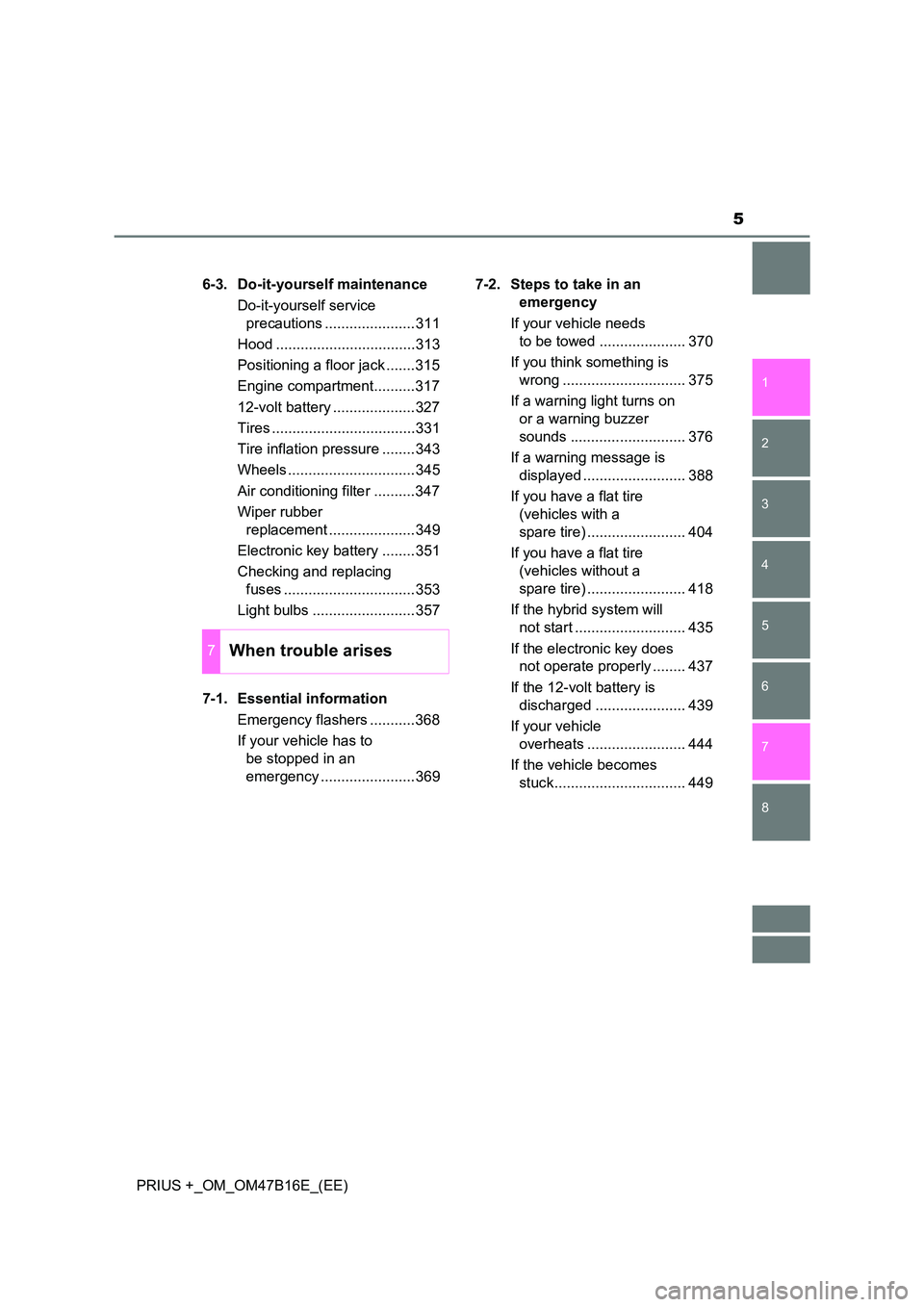
5
1
8 7
6
5
4
3
2
PRIUS +_OM_OM47B16E_(EE)6-3. Do-it-yourself maintenance
Do-it-yourself service precautions ......................311
Hood ..................................313
Positioning a floor jack .......315
Engine compartment..........317
12-volt battery ....................327
Tires ...................................331
Tire inflation pressure ........343
Wheels ...............................345
Air conditioning filter ..........347
Wiper rubber replacement .....................349
Electronic key battery ........351
Checking and replacing fuses ................................353
Light bulbs .........................357
7-1. Essential information Emergency flashers ...........368
If your vehicle has to be stopped in an
emergency .......................369 7-2. Steps to take in an
emergency
If your vehicle needs to be towed ..................... 370
If you think something is wrong .............................. 375
If a warning light turns on or a warning buzzer
sounds ............................ 376
If a warning message is displayed ......................... 388
If you have a flat tire (vehicles with a
spare tire) ........................ 404
If you have a flat tire (vehicles without a
spare tire) ........................ 418
If the hybrid system will not start ........................... 435
If the electronic key does not operate properly ........ 437
If the 12-volt battery is discharged ...................... 439
If your vehicle overheats ........................ 444
If the vehicle becomes stuck................................ 449
7When trouble arises
Page 15 of 496
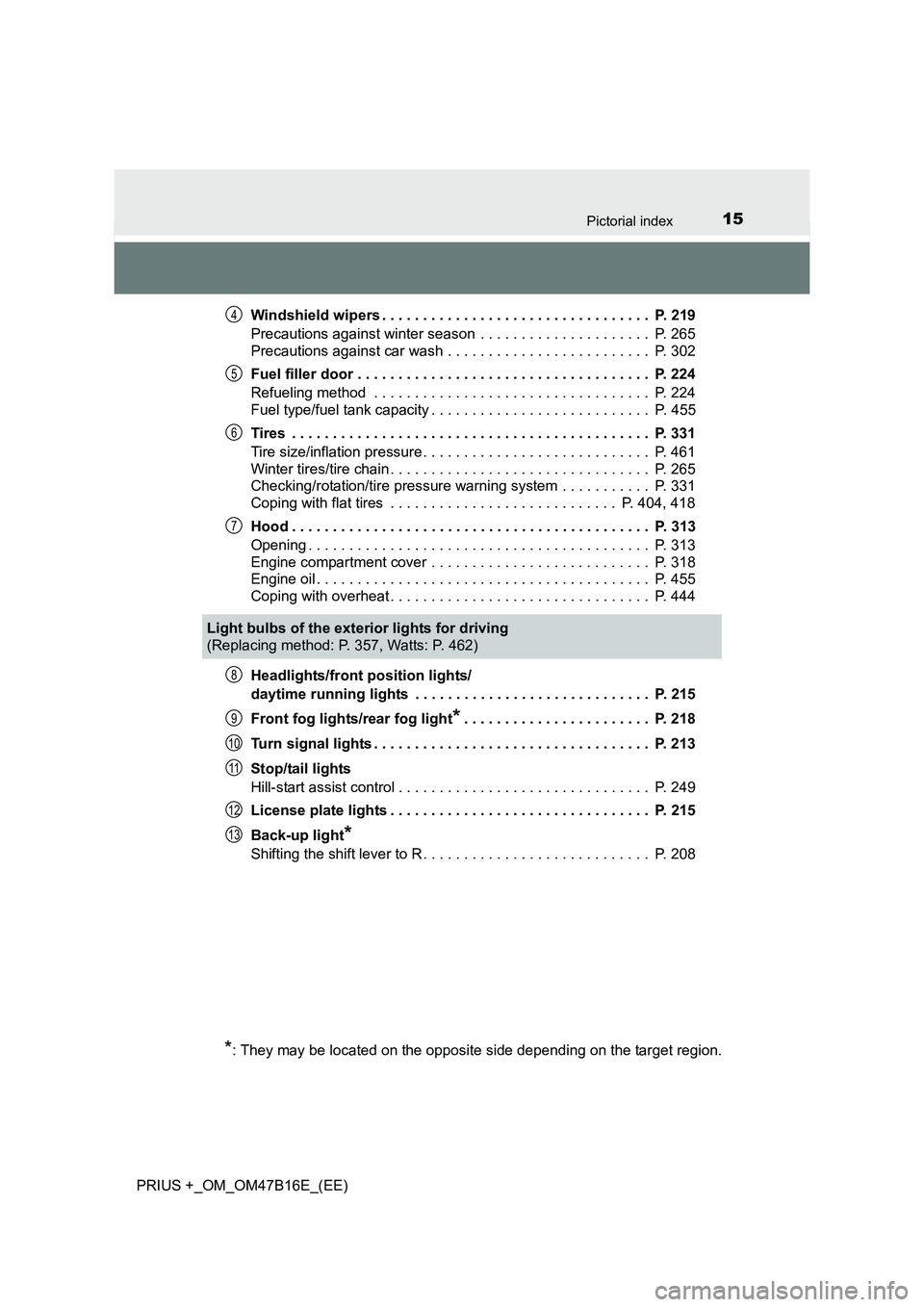
15Pictorial index
PRIUS +_OM_OM47B16E_(EE)Windshield wipers . . . . . . . . . . . . . . . . . . . . . . . . . . . . . . . . . P. 219
Precautions against winter season . . . . . . . . . . . . . . . . . . . . . P. 265
Precautions against car wash . . . . . . . . . . . . . . . . . . . . . . . . . P. 302
Fuel filler door . . . . . . . . . . . . . . . . . . . . . . . . . . . . . . . . . . . . P. 224
Refueling method . . . . . . . . . . . . . . . . . . . . . . . . . . . . . . . . . . P. 224
Fuel type/fuel tank capacity . . . . . . . . . . . . . . . . . . . . . . . . . . . P. 455
Tires . . . . . . . . . . . . . . . . . . . . . . . . . . . . . . . . . . . . . . . . . . . . P. 331
Tire size/inflation pressure . . . . . . . . . . . . . . . . . . . . . . . . . . . . P. 461
Winter tires/tire chain . . . . . . . . . . . . . . . . . . . . . . . . . . . . . . . . P. 265
Checking/rotation/tire pressure warning system . . . . . . . . . . . P. 331
Coping with flat tires . . . . . . . . . . . . . . . . . . . . . . . . . . . . P. 404, 418
Hood . . . . . . . . . . . . . . . . . . . . . . . . . . . . . . . . . . . . . . . . . . . . P. 313
Opening . . . . . . . . . . . . . . . . . . . . . . . . . . . . . . . . . . . . . . . . . . P. 313
Engine compartment cover . . . . . . . . . . . . . . . . . . . . . . . . . . . P. 318
Engine oil . . . . . . . . . . . . . . . . . . . . . . . . . . . . . . . . . . . . . . . . . P. 455
Coping with overheat . . . . . . . . . . . . . . . . . . . . . . . . . . . . . . . . P. 444
Headlights/front position lights/
daytime running lights . . . . . . . . . . . . . . . . . . . . . . . . . . . . . P. 215
Front fog lights/rear fog light
*. . . . . . . . . . . . . . . . . . . . . . . P. 218
Turn signal lights . . . . . . . . . . . . . . . . . . . . . . . . . . . . . . . . . . P. 213
Stop/tail lights
Hill-start assist control . . . . . . . . . . . . . . . . . . . . . . . . . . . . . . . P. 249
License plate lights . . . . . . . . . . . . . . . . . . . . . . . . . . . . . . . . P. 215
Back-up light
*
Shifting the shift lever to R. . . . . . . . . . . . . . . . . . . . . . . . . . . . P. 208
4
5
6
7
Light bulbs of the exterior lights for driving
(Replacing method: P. 357, Watts: P. 462)
*: They may be located on the opposite side depending on the target region.
8
9
10
11
12
13
Page 253 of 496
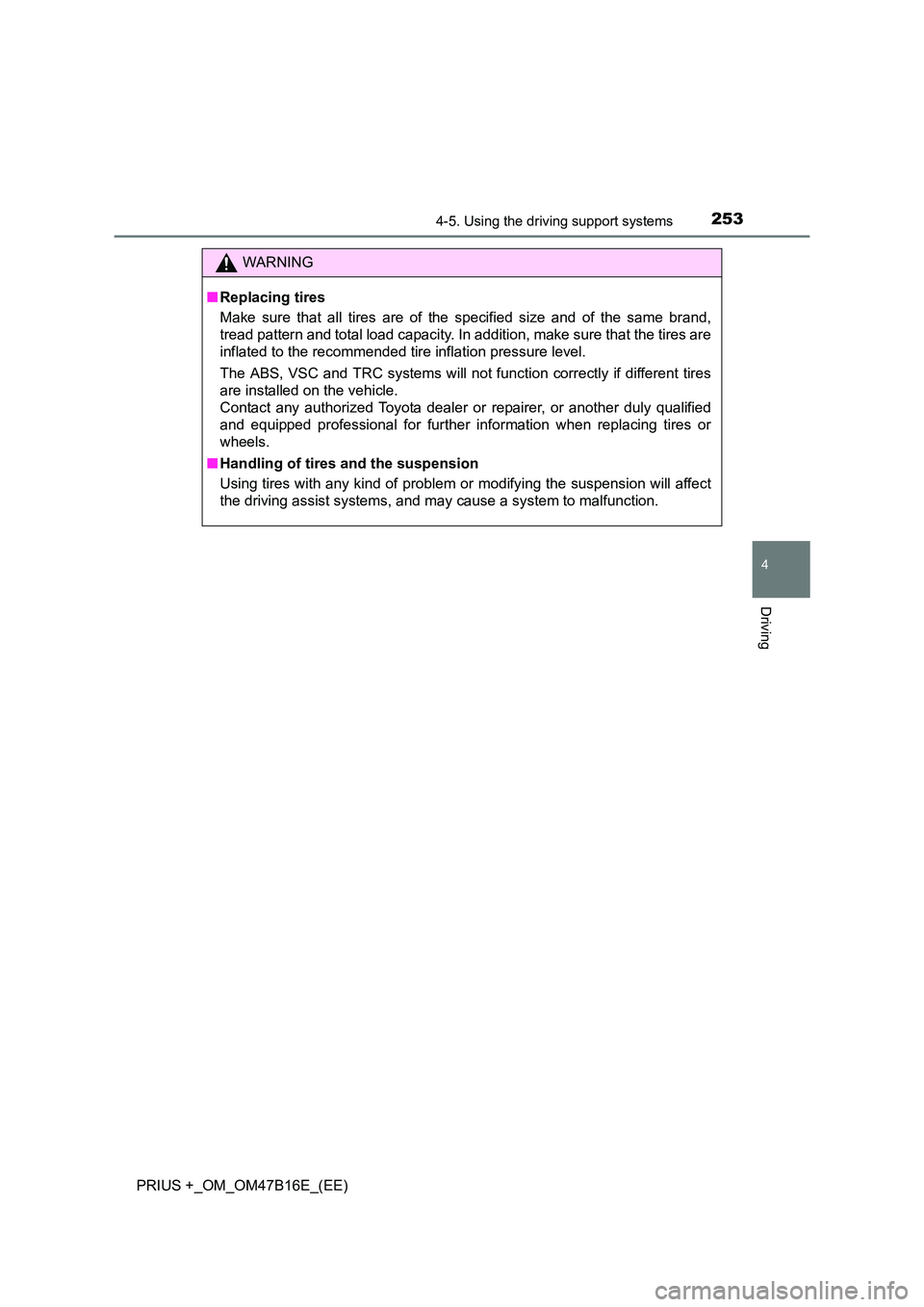
2534-5. Using the driving support systems
4
Driving
PRIUS +_OM_OM47B16E_(EE)
WARNING
■ Replacing tires
Make sure that all tires are of the specified size and of the same brand,
tread pattern and total load capacity. In addition, make sure that the tires are
inflated to the recommended tire inflation pressure level.
The ABS, VSC and TRC systems will not function correctly if different tires
are installed on the vehicle.
Contact any authorized Toyota dealer or repairer, or another duly qualified
and equipped professional for further in formation when replacing tires or
wheels.
■ Handling of tires and the suspension
Using tires with any kind of problem or modifying the suspension will affect
the driving assist systems, and may cause a system to malfunction.
Page 264 of 496
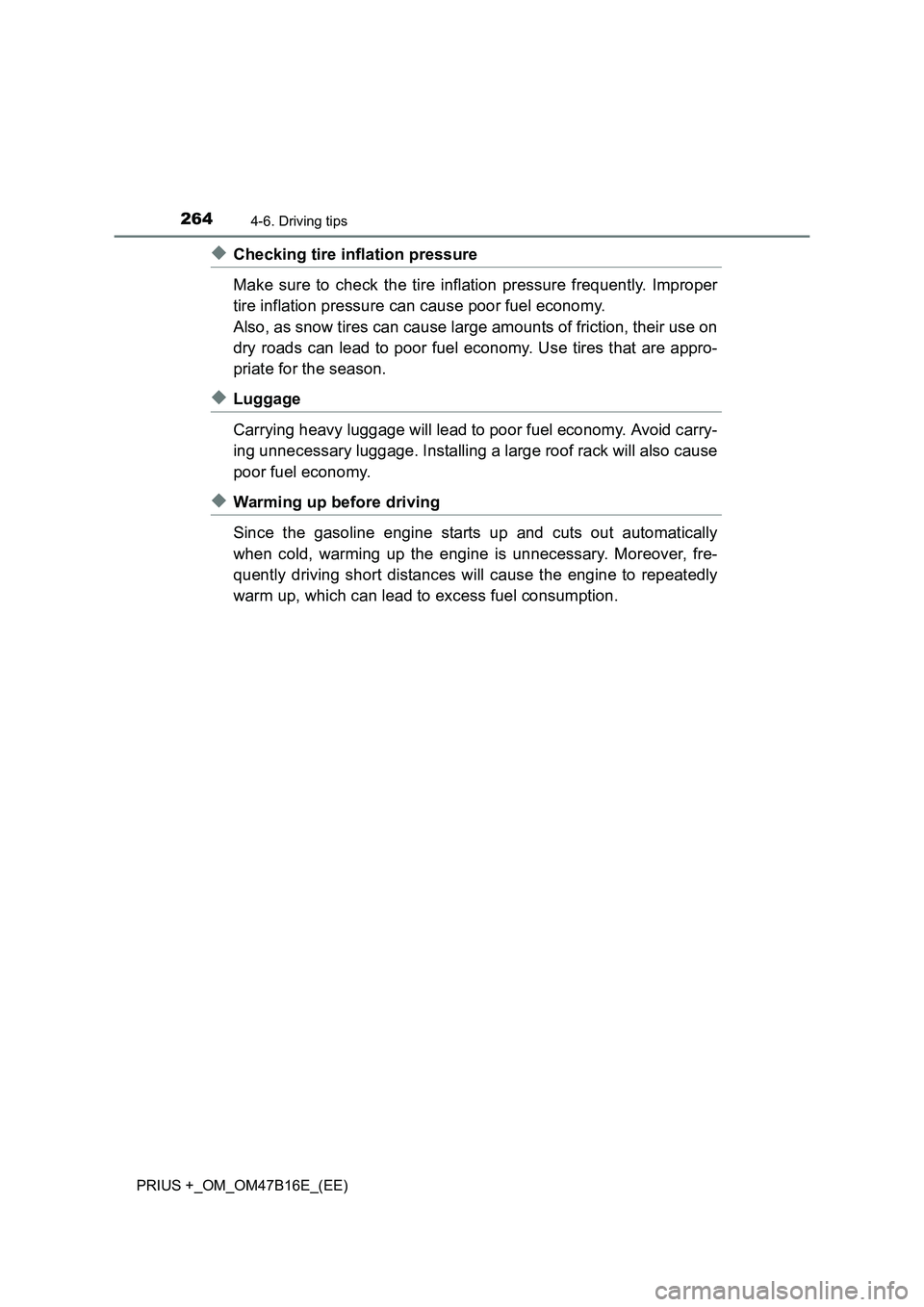
2644-6. Driving tips
PRIUS +_OM_OM47B16E_(EE)
◆Checking tire inflation pressure
Make sure to check the tire inflation pressure frequently. Improper
tire inflation pressure can cause poor fuel economy.
Also, as snow tires can cause large amounts of friction, their use on
dry roads can lead to poor fuel economy. Use tires that are appro-
priate for the season.
◆Luggage
Carrying heavy luggage will lead to poor fuel economy. Avoid carry-
ing unnecessary luggage. Installing a large roof rack will also cause
poor fuel economy.
◆Warming up before driving
Since the gasoline engine starts up and cuts out automatically
when cold, warming up the engine is unnecessary. Moreover, fre-
quently driving short distances will cause the engine to repeatedly
warm up, which can lead to excess fuel consumption.
Page 299 of 496
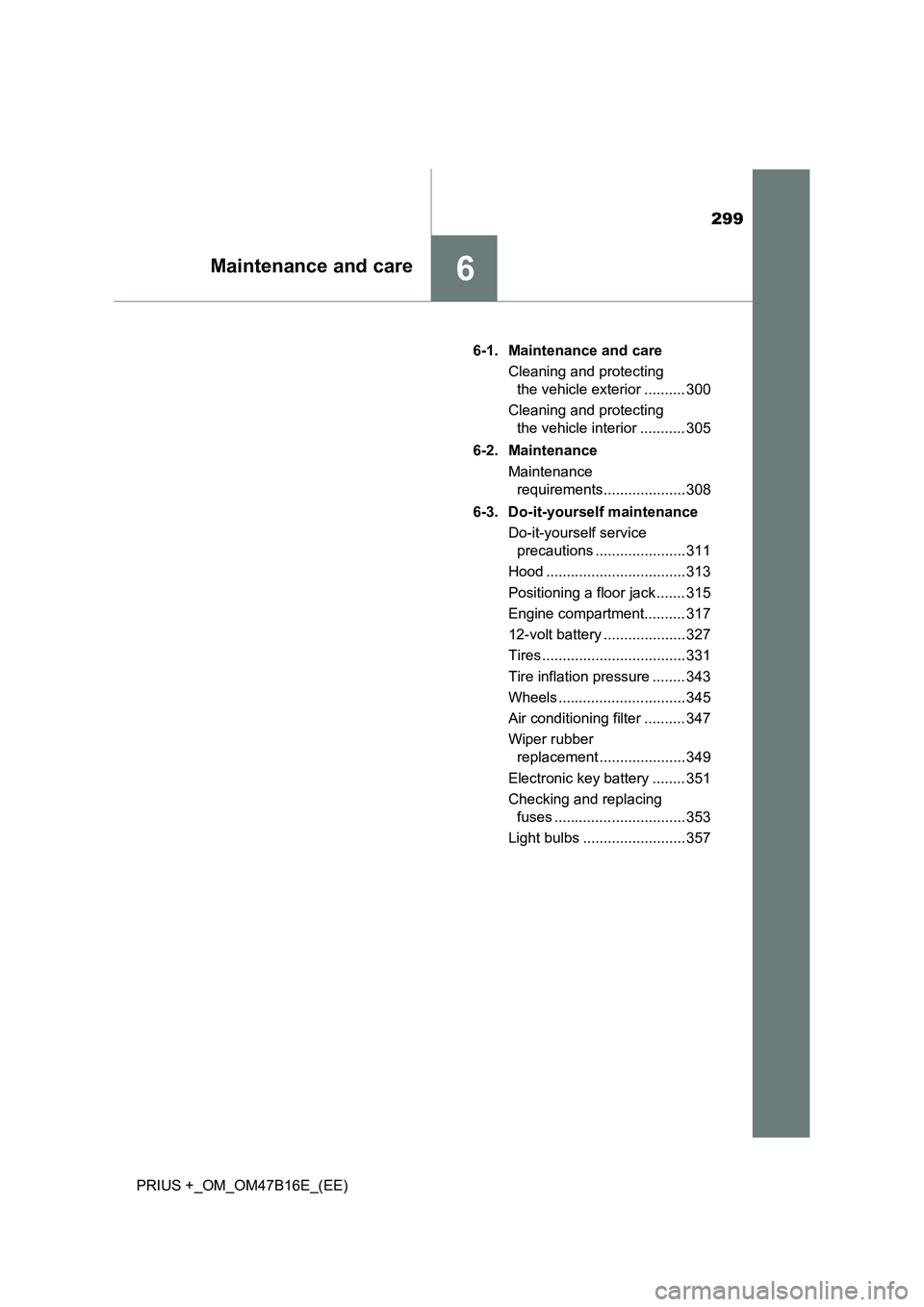
299
6Maintenance and care
PRIUS +_OM_OM47B16E_(EE)6-1. Maintenance and care
Cleaning and protecting the vehicle exterior .......... 300
Cleaning and protecting the vehicle interior ........... 305
6-2. Maintenance Maintenance requirements.................... 308
6-3. Do-it-yourself maintenance Do-it-yourself service precautions ...................... 311
Hood .................................. 313
Positioning a floor jack ....... 315
Engine compartment.......... 317
12-volt battery .................... 327
Tires ................................... 331
Tire inflation pressure ........ 343
Wheels ............................... 345
Air conditioning filter .......... 347
Wiper rubber replacement ..................... 349
Electronic key battery ........ 351
Checking and replacing fuses ................................ 353
Light bulbs ......................... 357
Page 311 of 496
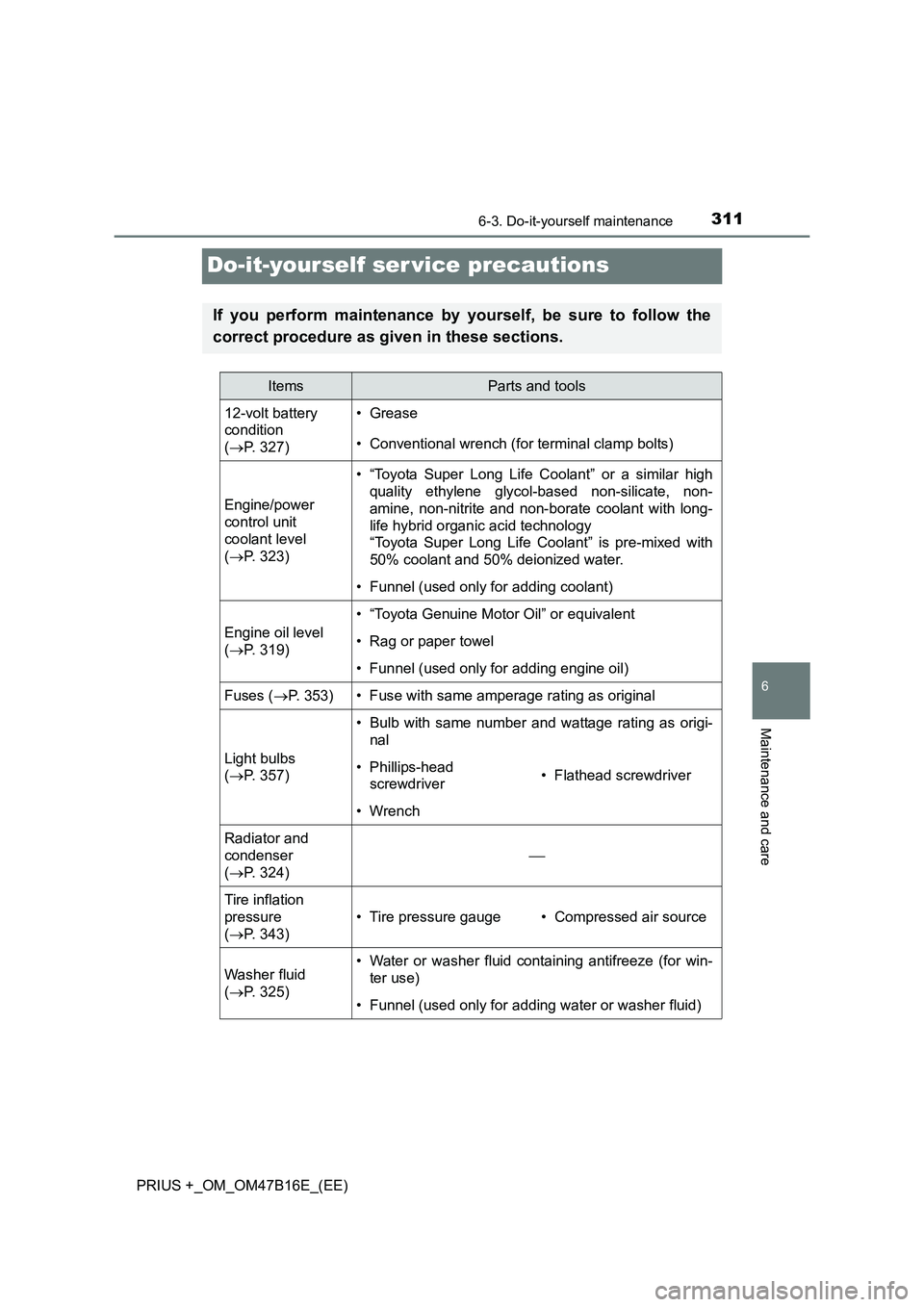
3116-3. Do-it-yourself maintenance
PRIUS +_OM_OM47B16E_(EE)
6
Maintenance and care
Do-it-yourself ser vice precautions
If you perform maintenance by yourself, be sure to follow the
correct procedure as given in these sections.
ItemsParts and tools
12-volt battery
condition
(→ P. 327) • Grease
• Conventional wrench (for terminal clamp bolts)
Engine/power
control unit
coolant level
(
→ P. 323) • “Toyota Super Long Life Coolant” or a similar high
quality ethylene glycol-based non-silicate, non-
amine, non-nitrite and non-borate coolant with long-
life hybrid organic acid technology
“Toyota Super Long Life Coolant” is pre-mixed with
50% coolant and 50% deionized water.
• Funnel (used only for adding coolant)
Engine oil level
(→ P. 319)
• “Toyota Genuine Motor Oil” or equivalent
• Rag or paper towel
• Funnel (used only for adding engine oil)
Fuses ( →P. 353)• Fuse with same amperage rating as original
Light bulbs
(→ P. 357)
• Bulb with same number and wattage rating as origi-
nal
• Phillips-head screwdriver• Flathead screwdriver
• Wrench
Radiator and
condenser
(→ P. 324)
Tire inflation
pressure
(→ P. 343)
• Tire pressure gauge• Compressed air source
Washer fluid
(→ P. 325)• Water or washer fluid containing antifreeze (for win-
ter use)
• Funnel (used only for adding water or washer fluid)
Page 332 of 496
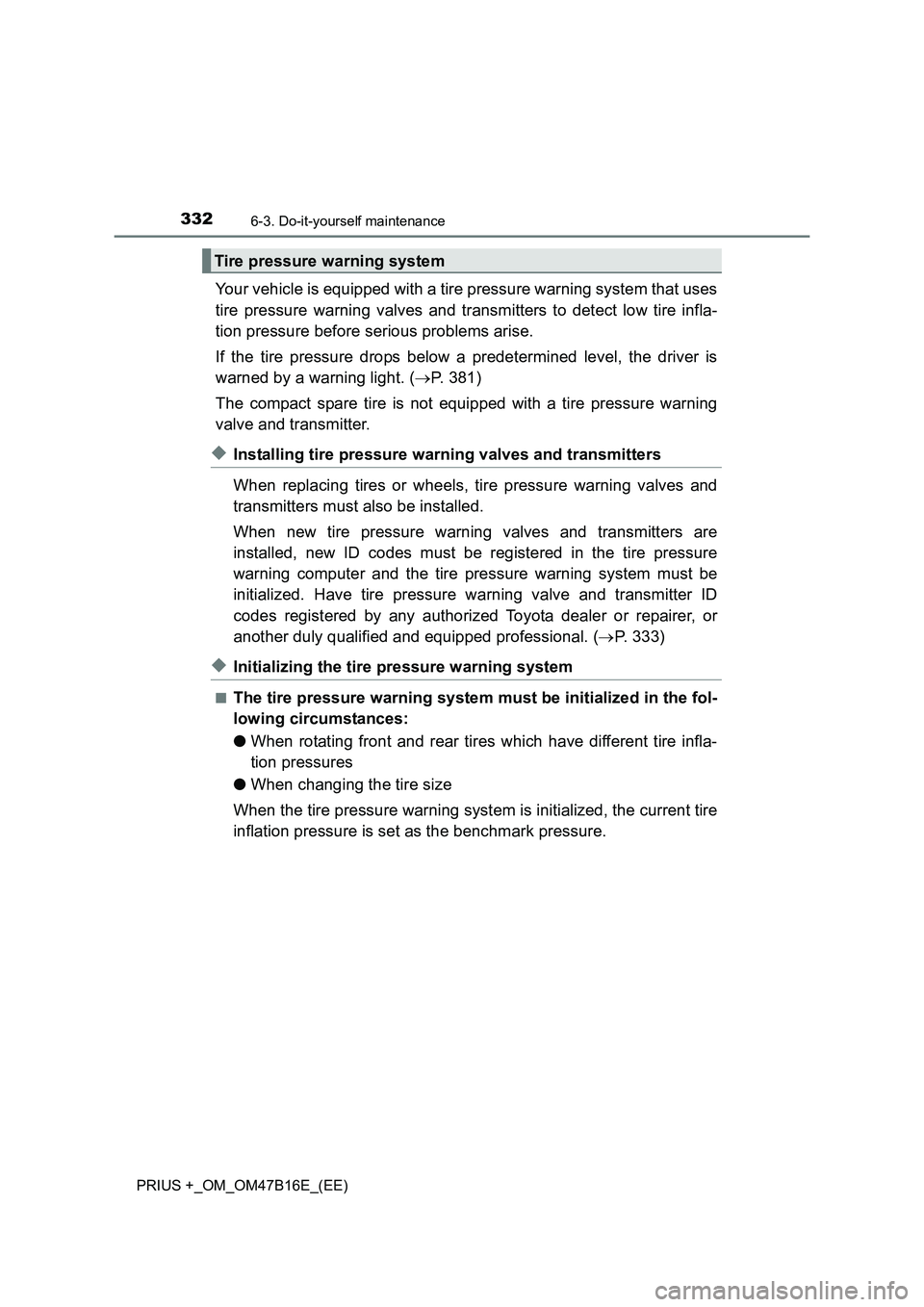
3326-3. Do-it-yourself maintenance
PRIUS +_OM_OM47B16E_(EE)
Your vehicle is equipped with a tire pressure warning system that uses
tire pressure warning valves and transmitters to detect low tire infla-
tion pressure before serious problems arise.
If the tire pressure drops below a predetermined level, the driver is
warned by a warning light. (→P. 381)
The compact spare tire is not equipped with a tire pressure warning
valve and transmitter.
◆Installing tire pressure warning valves and transmitters
When replacing tires or wheels, tire pressure warning valves and
transmitters must also be installed.
When new tire pressure warning valves and transmitters are
installed, new ID codes must be registered in the tire pressure
warning computer and the tire pressure warning system must be
initialized. Have tire pressure warning valve and transmitter ID
codes registered by any authorized Toyota dealer or repairer, or
another duly qualified and equipped professional. ( →P. 333)
◆Initializing the tire pressure warning system
■The tire pressure warning system must be initialized in the fol-
lowing circumstances:
● When rotating front and rear tires which have different tire infla-
tion pressures
● When changing the tire size
When the tire pressure warning system is initialized, the current tire
inflation pressure is set as the benchmark pressure.
Tire pressure warning system
Page 333 of 496
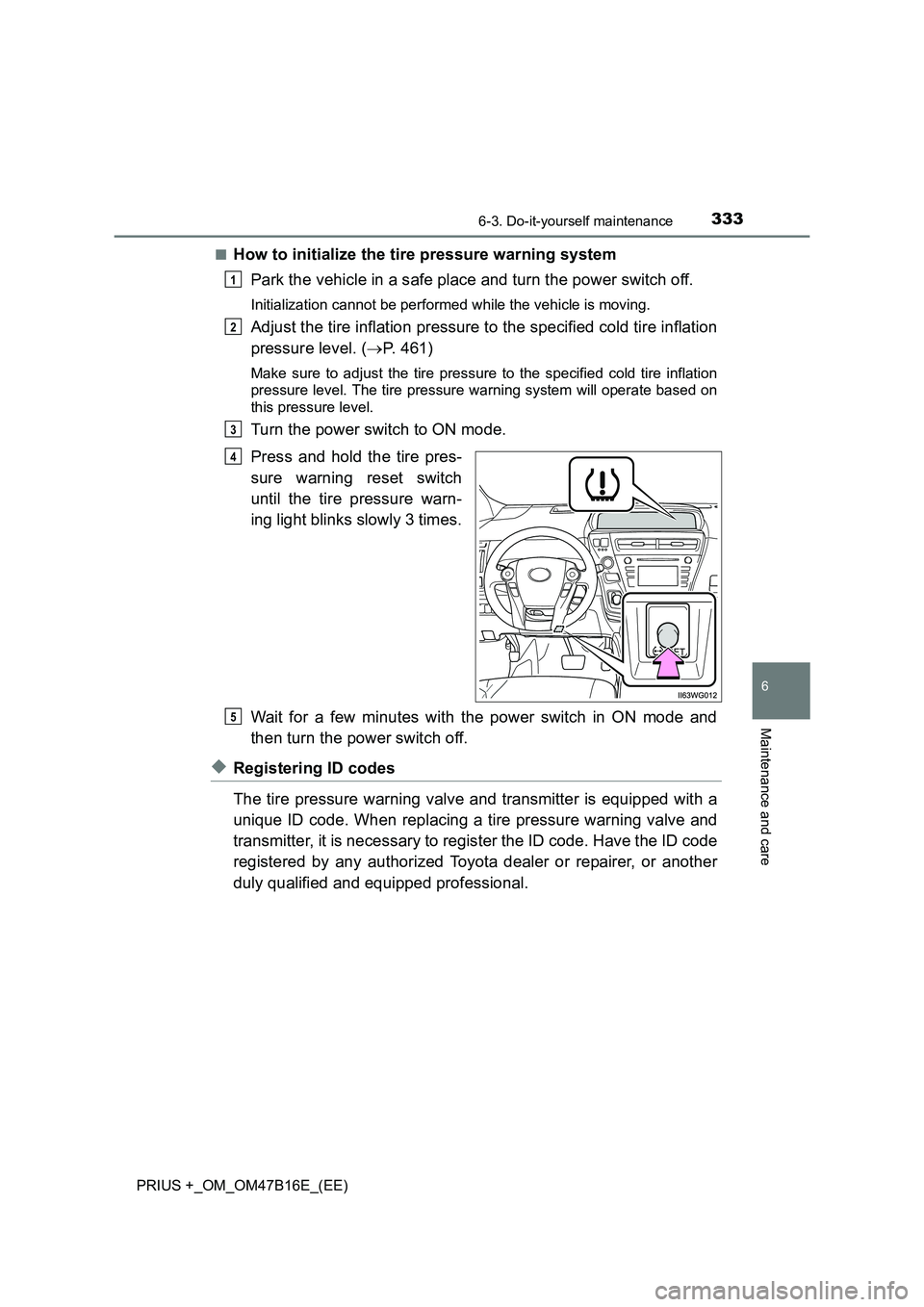
3336-3. Do-it-yourself maintenance
PRIUS +_OM_OM47B16E_(EE)
6
Maintenance and care
■How to initialize the tire pressure warning systemPark the vehicle in a safe place and turn the power switch off.
Initialization cannot be performed while the vehicle is moving.
Adjust the tire inflation pressure to the specified cold tire inflation
pressure level. ( →P. 461)
Make sure to adjust the tire pressure to the specified cold tire inflation
pressure level. The tire pressure warning system will operate based on
this pressure level.
Turn the power switch to ON mode.
Press and hold the tire pres-
sure warning reset switch
until the tire pressure warn-
ing light blinks slowly 3 times.
Wait for a few minutes with the power switch in ON mode and
then turn the power switch off.
◆Registering ID codes
The tire pressure warning valve and transmitter is equipped with a
unique ID code. When replacing a tire pressure warning valve and
transmitter, it is necessary to register the ID code. Have the ID code
registered by any authorized Toyota dealer or repairer, or another
duly qualified and equipped professional.
1
2
3
4
5
Page 334 of 496
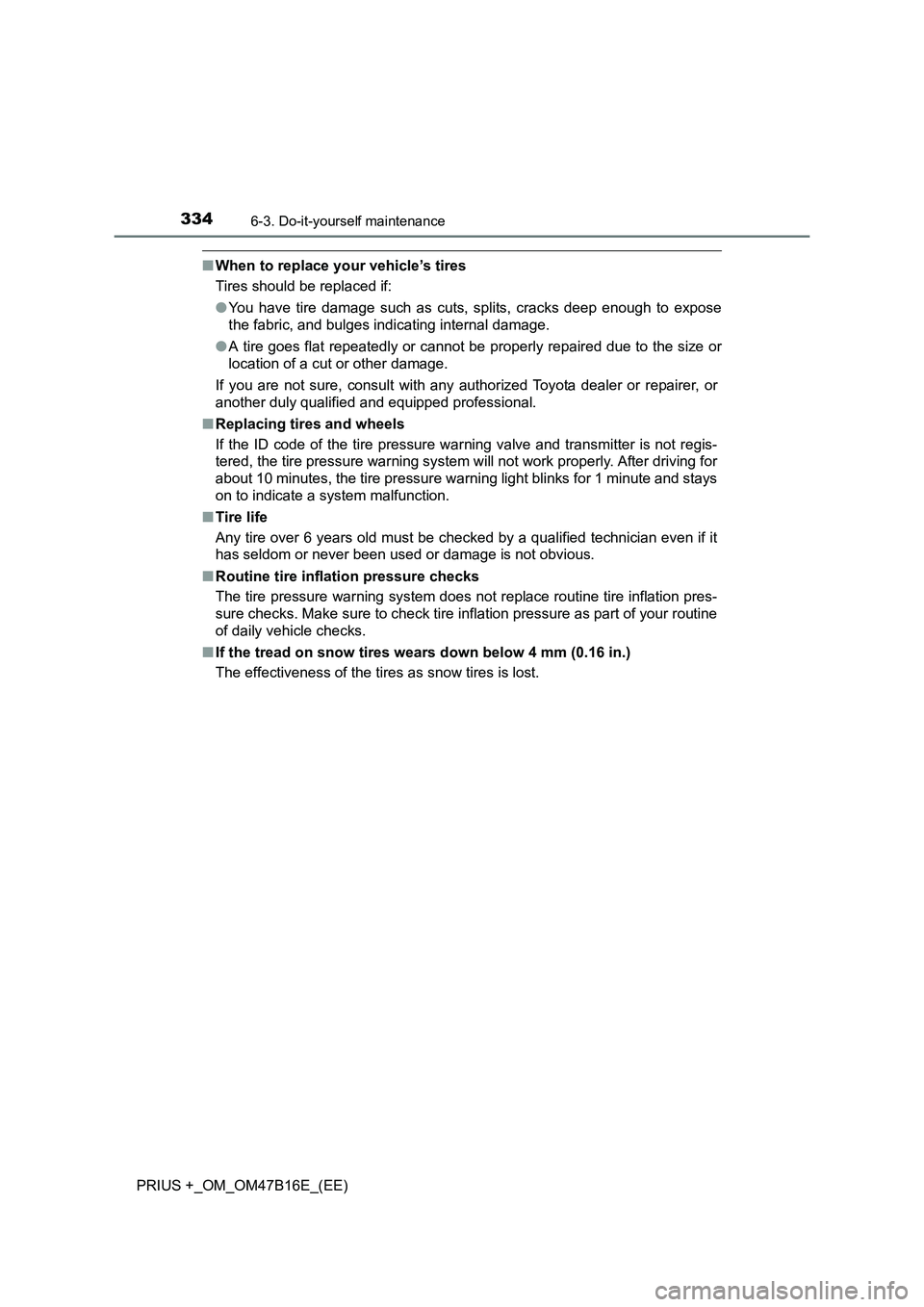
3346-3. Do-it-yourself maintenance
PRIUS +_OM_OM47B16E_(EE)
■When to replace your vehicle’s tires
Tires should be replaced if:
●You have tire damage such as cuts, splits, cracks deep enough to expose
the fabric, and bulges indicating internal damage.
● A tire goes flat repeatedly or cannot be properly repaired due to the size or
location of a cut or other damage.
If you are not sure, consult with any authorized Toyota dealer or repairer, or
another duly qualified and equipped professional.
■ Replacing tires and wheels
If the ID code of the tire pressure warning valve and transmitter is not regis-
tered, the tire pressure warning system will not work properly. After driving for
about 10 minutes, the tire pressure warning light blinks for 1 minute and stays
on to indicate a system malfunction.
■ Tire life
Any tire over 6 years old must be checked by a qualified technician even if it
has seldom or never been used or damage is not obvious.
■ Routine tire inflation pressure checks
The tire pressure warning system does not replace routine tire inflation pres-
sure checks. Make sure to check tire inflation pressure as part of your routine
of daily vehicle checks.
■ If the tread on snow tires wears down below 4 mm (0.16 in.)
The effectiveness of the tires as snow tires is lost.
Page 335 of 496
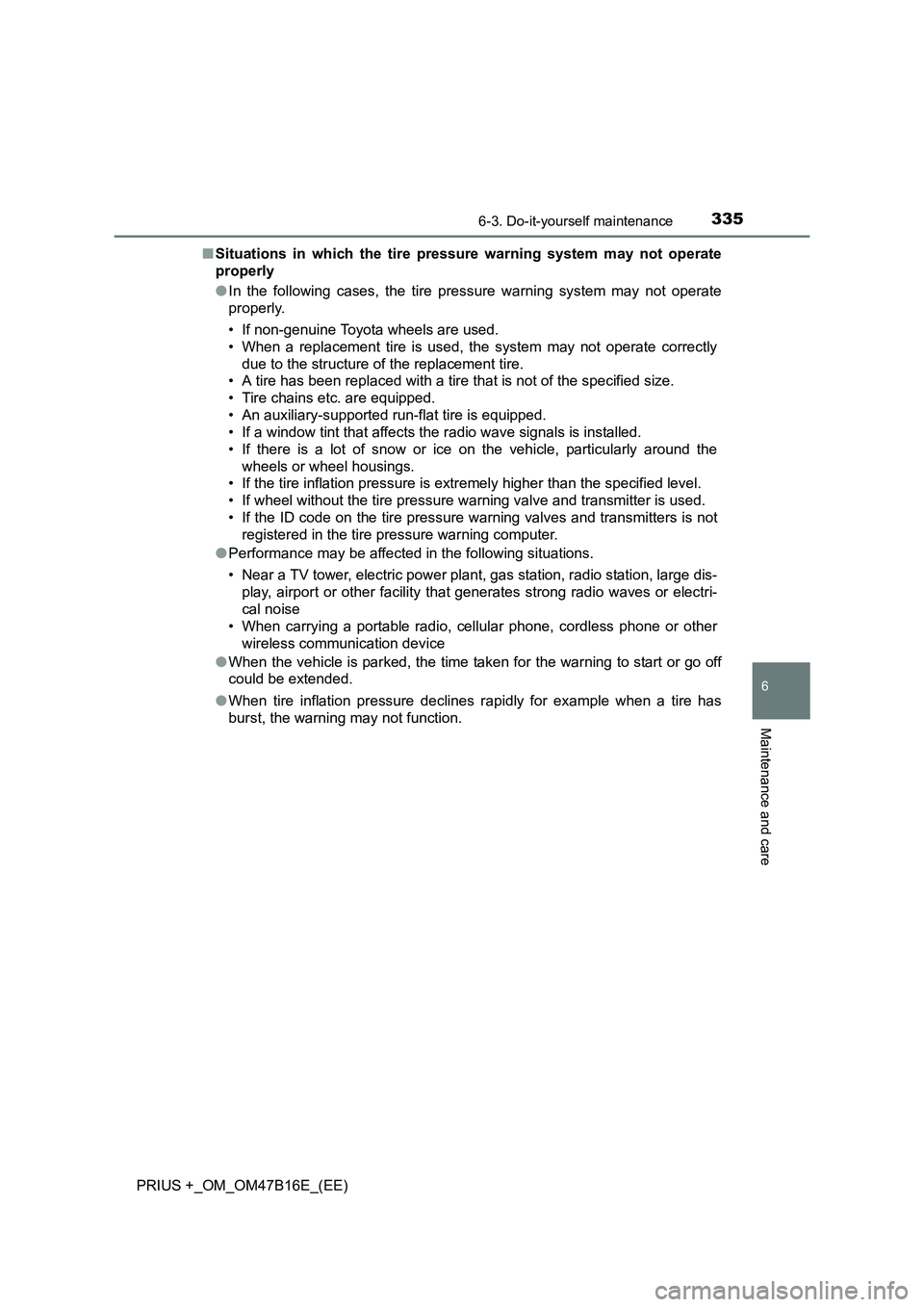
3356-3. Do-it-yourself maintenance
PRIUS +_OM_OM47B16E_(EE)
6
Maintenance and care
■Situations in which the tire pressure warning system may not operate
properly
●In the following cases, the tire pressure warning system may not operate
properly.
• If non-genuine Toyota wheels are used.
• When a replacement tire is used, the system may not operate correctly
due to the structure of the replacement tire.
• A tire has been replaced with a tire that is not of the specified size.
• Tire chains etc. are equipped.
• An auxiliary-supported run-flat tire is equipped.
• If a window tint that affects the radio wave signals is installed.
• If there is a lot of snow or ice on the vehicle, particularly around the
wheels or wheel housings.
• If the tire inflation pressure is extremely higher than the specified level.
• If wheel without the tire pressure warning valve and transmitter is used.
• If the ID code on the tire pressure warning valves and transmitters is not registered in the tire pressure warning computer.
● Performance may be affected in the following situations.
• Near a TV tower, electric power plant, gas station, radio station, large dis-
play, airport or other facility that generates strong radio waves or electri-
cal noise
• When carrying a portable radio, cellular phone, cordless phone or other wireless communication device
● When the vehicle is parked, the time taken for the warning to start or go off
could be extended.
● When tire inflation pressure declines rapidly for example when a tire has
burst, the warning may not function.